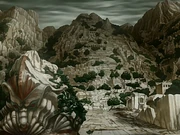| By The Snowbold | Part of the The Journey of Tala continuity. |
The Formation of the Earth Kingdom was a generation long war in which the King of Ba Sing Se took over the continent from the North all they way south and to the coastlands. The war culminated in a great siege of Omashu. Avatar Koru came towards the end of this war to mediate the negotiations between the two kings.
History[]
At this time in the world, the mainland was split into several kingdoms and city-states. The most prominent were Taku, Omashu, Gaoling, and Ba Sing Se. The City-State of Ba Sing Se had grown powerful because it couldn't be touched by invasions and so was thought invincible. But beyond the city, the borders were less certain as marauders from the Northlands constantly pillaged the vassal lands of the city. A general and head secretary of the government was sent to end the raids.
Battles and Campaigns[]
The Battles of this war were long and often many smaller battles that fit into a greater campaign, such as Taku's importance for the Coastlands.

The First Invasion Force, Ba Sing Se Infantry, Vanguard.
Taming the Northlands[]
The general not only succeeded but subjugated the savage Northlands, ending the raids and tripling the inflow of resources into the city. The general became incredibly popular and decided to use this newfound power to his advantage.
Storming the Southlands[]
To gain more support amongst the people of the massive city, this general led more armies. Instead of north, which had been won, he invaded South. This included the Si Wong Valleys, the Great Divide, and other lands, many ruled by Omashu and Gaoling. There was little actual war for the first three years as the two great cities hoped to broker a peace with the invaders; but after more lands fell, the Kings rose to arms.
Coup D'État of Ba Sing Se[]
Things in Ba Sing Se became incredibly hostile. The traditional leaders of the great city were content to govern their borders and not expand. They showed misgivings about the Northlands being taken and were publicly opposing the Southlands invasion. But this was opposite public opinion. The city was wealthier than ever, especially in trade and food.
The leaders attempted to arrest the general on his return to Ba Sing Se, but instead he launched a Coup D'État and took over the city, naming himself the King of Ba Sing Se. He became known as the Wall King after he stayed behind his walls thereafter, fearing assassins.
The war continued in a stalemate for the next five years against the loose confederation of Kings and leaders against Ba Sing Se.
Invasion of Taku[]

The great trade city of Taku
The Usurper King of Ba Sing Se died of sickness and was succeeded by his son, a renowned commander himself. This King revitalized the war, focusing the armies west instead of south. He turned onto the great trade-port city of Taku.
Taku was a wealthy city that had great relations with Omashu, where it claimed heritage from. But too far away from the other allies; Taku was soon isolated and taken by the King of Ba Sing Se. Taku had the greatest navy in the continent, but it meant little when an army invaded from the east. Ba Sing Se now had the naval capabilities to move for the Southlands as well as march an army.
Betrayal of Gaoling[]

The city of Gaoling decided to switch sides seeing the progress of the war.
As the war continued and Ba Sing Se now had a fleet to harass the Coastlands, the King of Gaoling saw the writing on the wall and made a secret agreement with the Wall King.
In an important battle between Ba Sing Se against Omashu and Gaoling; Gaoling betrayed its allies and turned the tide of war in their favor. Only one banner from Gaoling stayed loyal to Omashu in the battle, that of the Flying Boar. The Beifongs lost many of their finest leaders in this battle, but swore revenge against their king. Gaoling did not favor their leader's decision.
Gaoling was then apart of the new and growing kingdom but stated to have its own regent. However, this regent, formerly the king, died of mysterious circumstances soon after. The Beifongs killed any who would take his position and soon ruled Gaoling, but could not overthrow the Ba Sing Se occupation.

The Flying Boar of the Beifongs stood defiant to Ba Sing Se and caused years of troubles for their occupation in Gaoling.
Liberation of the Southlands[]
While Gaoling fell by treachery; it had unexpected setbacks for Ba Sing Se. The Beifongs proved to be more dangerous than expected. While unable to remove the occupying forces, their constant attacks sapped the resources of the invasion. Omashu and its allies were able to liberate their territory from the invaders. Only Gaoling remained a foothold for Ba Sing Se in the Southlands towards the end and stayed so for another four years.
Subjugation of the Coastlands[]

Ba Sing Se tightened its control of the seas to prevent the enemy from striking secure locations in the north.
The next King of Ba Sing Se refocused his efforts on the Coastlands, using his expanding navy to solidify control of the seas. From Taku to Gaoling, he soon had complete domination. He spent nearly three years doing this.
This was also done to secure the north and to prevent enemy supplies from potential rebels in Taku. By the time of the next campaign, Ba Sing Se had no challenger to its naval might.
The Siege of Omashu[]

The great Kingdom of Omashu stood defiant against Ba Sing Se till only they remained.
After failing to take the Southlands due to supply problems and the fact that Omashu sent aid to any ally in danger, it seemed impossible to win the final piece of the continent.
The King led an invasion larger than any before and laid siege to Omashu. This siege lasted for more than eight years and saw devastating casualties. The allies of Omashu soon realized the master strategy. With Omashu enclosed and defending itself, the rest of the lands were open to invasion. Without the help of their greatest ally, they soon fell to attacks. Omashu was all that was left.
In the hope to bring a quick and brutal end to the war, the King of Omashu declared he would ride to war against the King of Ba Sing Se, a challenge that was accepted. Unknown to the Wall King was that Omashu had a secret tunnel that led past the Cave of Two Lovers and into a great valley. Omashu had figured that the Wall King set camp there because of its great staging point. The large force they sent found nothing and had to search for him.
They arrived in the nick of time and wrought devastation on invaders and soon the Wall King was pinned between two armies. Despite this huge disaster, he was able to lead his army out of it and beat the defenders back into their city, battered and broken.
The Wall King had no idea of the state of the city; but was not willing to risk another ambush, as his own forces were heavily depleted. He sent messengers to first declare a cease-fire and then negotiations.
End of the War[]
It was this time that the Avatar, Koru returned to the mainland. Having tried to end another generation-long conflict in the Fire Nation, Koru had done nothing to stop the War of Ba Sing Se. When he arrived, the Wall King agreed to a cease-fire. Koru advised both kings to negotiate to a compromise.
This deal was made that: "The city shall neither be occupied nor its King deposed. The city shall be free to enact its own laws as a semi-autonomous city. But in return for this guarantee, the city of Omashu must swear loyalty to I, the King of Ba Sing Se; and so must every King of Omashu from here forward. Omashu must muster troops to our banners as commanded and pay a tax of ten percent on all profits, no more no less. And to ensure that the City remembers this pact, we shall have either originals or copies of all documents pertaining to this agreement in both the new University of Ba Sing Se and the Library of Records here in Omashu. This includes the excavation maps of the tunnel, confirmed by Avatar Koru of the North Pole; and a map of the Palace of Omashu."
To ensure the King of Omashu's rule, he had to give up how he snuck an army around the Wall King, revealing an ancient tunnel used to build Omashu. This along with other agreements were overseen by the Avatar and agreed upon.
Results[]

What Ba Sing Se's territory was before the war.
The Wall King soon started calling himself the Earth King. While Koru thought is was absurd, the name persisted and stayed. The entire empire he and his forefathers conquered became collectively known as the Earth Kingdom.
Millennia later in 319 AG, Crown-Prince Kiir, descendant of the Kings of Ba Sing Se used the knowledge of this tunnel to lead a small elite force into the Omashu Palace to take it and the King of the city to end the siege of the city.

The entire Earth Kingdom after the war and the way it would remain until Sozin's Comet.
Notes[]
1. Avatar Koru had done nothing to interfere in this war for several reasons.
- When it started, it was a General ending raids against his home.
- The Avatar was still training in airbending and mastering the Avatar State and so was not ready for small territorial wars.
- An issue of succession soon exploded in the Fire Nation as a Princess and her younger brother vied for the Throne of the Fire Nation. A bloody civil war broke out and lasted even when the siblings died. Koru spent the better part of a dozen years trying to end the war. For the numbers, it was a bloodier war than the unification of the continent.
- When he returned, a bloody, generation long campaign had unfolded across the mainland.
2. The Earth Kingdom was at its height in military power and strongest in the world at this time and for a long time afterwards.
3. Until the Hundred Year War, this was the longest war in the history of the world not involving an Avatar. Over twenty-five years of war was waged as Ba Sing Se subjugated the entire continent.
See more
For the collective works of the author, go here.